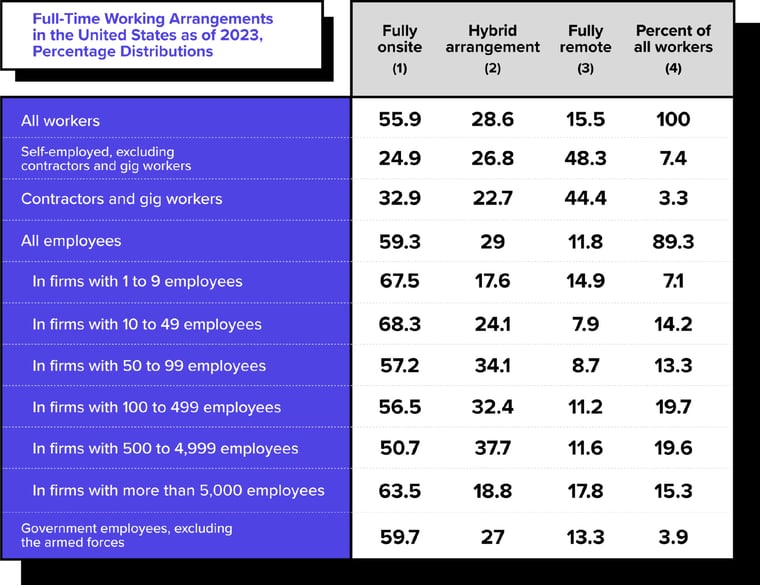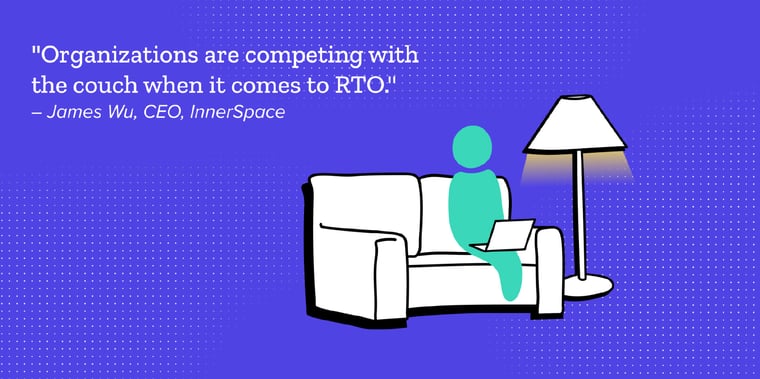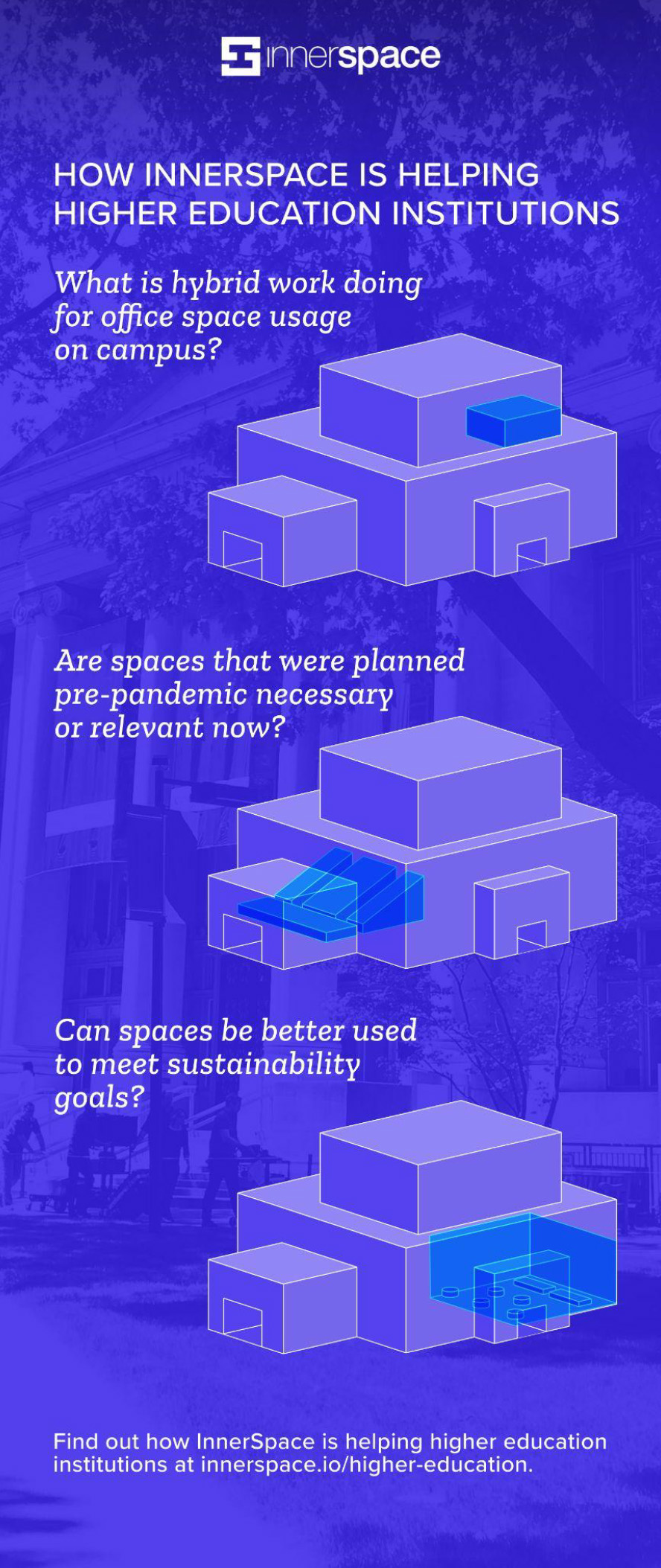The Future is Flexible
A look back on 2023, and a look forward to 2024 with InnerSpace

Top trends coming out of 2023 from InnerSpace
2023 was a big year for work. A lot of offices and businesses started off the year with return to work plans, as life normalized after the pandemic. Many businesses found the need to establish new normals, and some were more successful at it than others. We saw the beginnings of what might be a revolution in the way we work, as hybrid work became the norm in many industries.
It’s been a big year for InnerSpace too. Here are some of the trends we picked out in 2023, and where we think spatial intelligence and workplace design are heading in 2024.
Trend 01
The five-day (in the office) workweek is dead.
In the spatial utilization and commercial real estate world, 2023 will go down as the year where everyone was supposed to return to the office. Everyone, from big corporations to governments, to small businesses and everyone in between rolled out RTO mandates, and…it did not go as expected. Or maybe it went exactly as expected, depending on who you ask.
RTO mandates shook loose a lot of the issues employees had with the office, before the pandemic. The pandemic proved that employees could work at home, in many cases as efficiently as they could work at the office. It also gave employees a taste of how their lives could be enriched, with a little more flexibility when it came to when and how they worked (in 2024, we’ll explore the flip side of this).
Stanford Economist, and hybrid work expert Nicholas Bloom has spent the last few years analyzing hybrid work data, and found that, by Fall 2023, almost half of all workers in the United States were working hybrid or remote.

Source: Journal of Economic Perspectives—Volume 37, Number 4—Fall 2023
Today, businesses are facing the Great Resistance. After more than two years of remote working, flexible scheduling, and zero commute time, many workers are refusing to head back to the office. – Nicholas Bloom, Stanford University
Trend 02
RTO Mandates, a big why from employees, and not enough reasons from companies.
“Why?” is a big question that many employees are asking, and without a compelling case, RTO mandates have fallen flat, with many employees quitting, or refusing to comply. No one wanted to lose the flexibility that they’d gained during Covid, even if they did want to return to the office for part of the time.

There is an opportunity for offices to adapt to the new way of work and meet the needs of their teams. Whether it is more meeting rooms, collaboration spaces or stations for focused work, the way your teams are using the space today can deliver some important insights on what they need moving forward.
The onus is on organizations to make the office a compelling place for employees based on their new utilization needs. We are working with our clients today to deliver best-in-class data and utilization insights that are informing workplace design changes to drive better productivity and efficiency overall.
Trend 03
Business leaders are making forward thinking moves beyond sensors and badge swipes:
At InnerSpace in 2023, we continued to see a growing number of clients really understand the value of advanced spatial utilization data in their businesses. With this, came a realization of some of the flaws and limitations in the way they’d been people counting with badges and sensors, including:
- Badges count people coming in and out of a space, but that’s about it. We heard about organizations where employees would swipe in for coffee, or a free lunch, and that was about it. They did not have any sense of how their teams were using the space (or not) once they arrived.
- Sensors don’t have a great range, and don’t provide a story about how teams actually use the office. They don’t let you know which people are where, and how often, which is crucial to understanding how your space is being utilized.
To truly understand how your teams actually use the space, how they navigate through your space, what rooms they use and when/how long they are standing in cafeteria lines or looking for meeting rooms, you need actual utilization data. These kinds of insights give you the data you need to make functional decisions about workspace planning and create a more productive space that employees will use more effectively.
Trend 04
Higher Education embraced spatial utilization data in a big way:
InnerSpace spent the last half of 2023 connecting with Higher Education institutions, many of whom were seeing big changes in the way their campuses were being used post-pandemic. Many institutions had similar questions they needed spatial utilization data for:
- Figuring out what hybrid work was doing for office space usage on campus
- Evaluating capital costs; were the spaces they’d planned pre-pandemic necessary or relevant now?
- Finding ways to use spatial utilization data to meet sustainability goals
Our work with higher education sites has been incredibly interesting, and our robust data is supporting evidence-based decision-making on a growing number of campuses. We’ve demonstrated that our Wi-Fi based solution is secure, and hands down the best way for higher education institutions to get a broad, accurate look at their entire real estate portfolio to make decisions around investing. Some of the wins we’ve supported on campus so far include:
- Finding an entire building’s worth of office space without putting a shovel in the ground
- Discovering that a parking lot they’d planned was no longer necessary
- Having the data to confirm that costly new lab space wasn’t required; just a new scheduling system
Trend 05
The office isn’t done changing yet. Employees are seeking focused, quiet spaces to work.
We’re seeing a fresh shift away from the office being a collaborative space to a desire for private, focused spaces. This table, from one of our clients shows the change from the past data in the previous column, where collaboration was a huge reason why people were coming into the office to a huge leap in a desire to focus when in the office.
| AVERAGE SPACE TYPE USAGE | ||
| SPACE TYPE | NOW | PREVIOUS |
| Focus | 47.7% | 10.5% |
| Collaboration | 47.7% | 70% |
| Rejuvenation | 47.7% | 19.5% |
Here’s data from a client case study that shows an increased preference for focus space:

Why this shift? With the pandemic keeping everyone working from home, it made sense that people would want to socialize and collaborate in person in the office. Now though, after years of not enough delineation, employees are seeing the value between the separation of work and home.
Home is where the kids are. It’s where the pets are. It’s where the laundry is. Collaboration is great, but sometimes it’s really nice to put your head down and get to it, and our data is showing that.
As we say goodbye to 2023, we imagine a bigger role for spatial intelligence in every office in 2024 and beyond.
We think 2024 will be when we drop the RTO conversation and really begin to look at what the future of work will look like, from a spatial intelligence informed perspective. We’re hearing that business leaders are:
- Looking to understand why people go back to the office, and how to get them there in a changing work ecosystem
- Needing to get the best ROI on their office space investments
- Trying to understand what is happening with hybrid work in an immediate sense, and how it will evolve their business in the future.
These are all areas where spatial intelligence data can support decision-making that will keep teams engaged and help companies capitalize on their investments.
A look forward to 2024 and beyond: InnerSpace’s picks for top trends for the next year.
2023 has been a year of great change at InnerSpace and in the commercial real estate industry. As we move into 2024, we’ve seen the beginnings of a lot of industry trends in 4Q that we imagine will shape commercial real estate, and the office going forward. Here are what we see as the top trends to watch in 2024:
Workplaces that embrace flexibility will be the big winners in attracting and retaining top talent.
We think business innovators and leaders will let flexibility lead in 2024 and beyond. This has been proven both in terms of employee happiness and, maybe most importantly in revenue growth. Below is some important indicators of a recent study on workplace flexibility;
“An analysis of 554 public companies that employ a collective 26.7 million people found that “fully flexible” firms — which are either completely remote or allow employees to choose when they come to an office — increased sales 21 per cent between 2020 and 2022, on an industry-adjusted basis. That compares with five per cent growth for companies with hybrid or fully on-site workforces.”
Hard to argue with those numbers. Another place we imagine flexibility? Lease terms. 2023 has been a lessor's market, and we imagine this will continue too, as there are more spaces than firms to fill them. It’s important for leasers to understand their business’ current workspace needs before making changes to their space. This is where InnerSpace can help.
Sustainability will be a focus in an increasing number of organizations.
If you’re a firm that hasn’t been talking about ways to improve sustainability in your business, you’re in the minority (and you might want to catch up). Sustainability is more than a buzzword, and big companies are taking a serious look at their business practices and ways that can improve their corporate footprints when it comes to the way their operations work.
One big metric? Commuter time. Americans spent 7 billion hours commuting last year. This the same amount of effort it took to put a man on the moon. This time is not just about the time (which commuters might disagree with), but emissions.
Finding ways to improve sustainability goals will be top of mind in 2024, especially when they closely align with the opportunity to improve your employees’ overall experience. Time saved commuting in a flexible work week is time employees get back to spend with their families, or doing the things they care about, while supporting reduced emissions.
In 2023, our clients were thrilled with the sustainability gains they got while revamping their offices with data. We are excited about our continued contributions to improving carbon emissions across the board with our clients and providing insights to improve the overall experience of employees who commute in 2024.
Check out these sustainability gains from a Fortune 100 company that we worked with:
.jpg?width=760&height=428&name=InnerSpace%20-%20Workplace%20Solutions%20-%20Jun%2029%2023%20%20(1).jpg)
Companies who take risks will come out on top.
Fortune favours the bold, right? We think so, but we also think that boldness in businesses with spatial intelligence data to back it up goes even further. Here’s a few opportunities we think could be game changers with spatial intelligence data in 2024:
Smart businesses will capitalize on the leaser’s market.
It’s a leaser’s market right now with sweetheart rent deals available with less demand for office space. Knowing what you need, in terms of space types, square footage, and amenities, with the data to back it up will give you the upper hand as you set yourself up for cost savings at lease renewal time.
Commercial real estate is a changing market, and having accurate and current utilization data will help on that side too, both for lessors who are negotiating, and for real estate owners providing tenants with the best possible service.
Investing in spatial utilization data will save employees time in 2024 (and in turn, will save organizations money).
We imagine spatial utilization data showing up for employees in a big way in 2024, in time savings. A couple of applications? Real time digital signage that lets you know how busy certain spaces are, and avoiding them until they’re not so busy. Waiting a few minutes until the lunch room has calmed down might mean a few extra minutes to stay on task. Improvements in scheduling through data will help employees save time and in turn be more productive too. If you’re able to know the room types your teams are using, it means they’ll have better access to the spaces they need, when they need them.
The return on investment in best-in-class data will pay off.
For most businesses, their spaces are their first or second biggest line item, second only to staffing. Imagine being able to balance both line items more efficiently with the data to ensure they’re both giving you the best ROI. It’s possible, and will be more and more important as we move into a leaner time with higher interest rates.
AI applications will infiltrate and evolve the commercial real estate market (along with almost every other industry).
It wouldn’t be a complete look forward if we didn’t mention AI. The truth is, we’re excited about AI applications in our industry, which is data focused at its core. We see AI bringing a lot of additional depth to our insights going forward.
We imagine the data sets we work with growing over time, and AI being essential to bringing automated insights into Intello, our analytics dashboard even more quickly, with more detailed applications than it currently provides. We also imagine AI will help us quickly scale and integrate multiple data sources into a rich space utilization story which means even deeper insights which drive workspace productivity and efficiency.
Let’s connect in 2024!
2023 was a great year at InnerSpace. We connected with business leaders, attended conferences, and were able to work with industry leaders to get them the best data to make the right decisions around their space, meet their sustainability goals, and save money.
Where do you think spatial analysis is going? Are you ready to talk about how our insights can support your business in 2024? We’d love to connect and help you move your business forward with best in class spatial intelligent insights.
Accurate space utilization data through Wi-Fi?
We'll prove it to you.
See why industry leaders leverage InnerSpace to generate valuable insights that go beyond occupancy.


